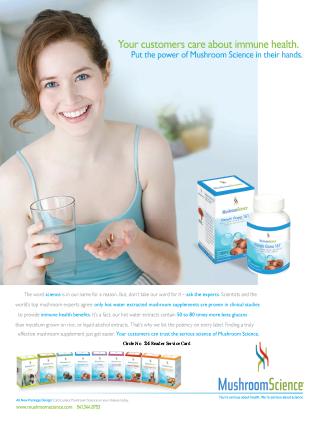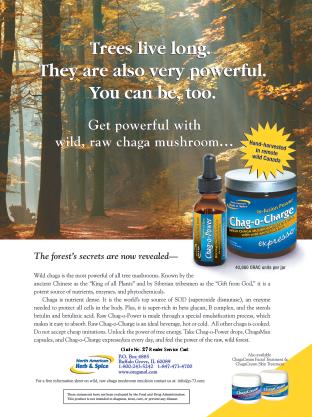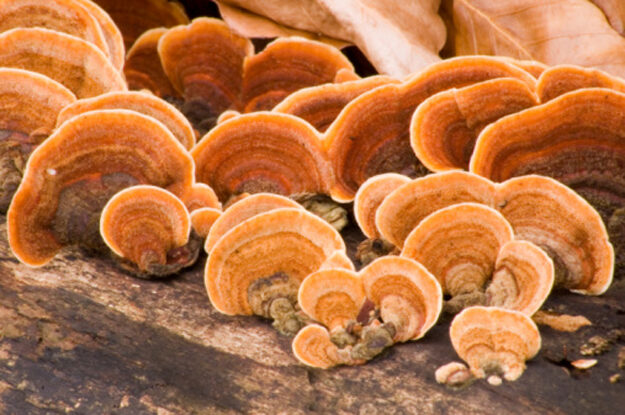It isn’t a secret that mushroom supplements are effective for improving our health in many areas. The research on the subject is diverse, and is often positive: nutrients in mushrooms can help keep us healthy. And, the rush of evidence doesn’t show any signs of slowing. The news is so good that it may have consumers thinking they should just gobble up any mushroom product they can find and enjoy the results. There is, however, a better way to go about it. This article will endeavor to break down the benefits that mushrooms can have for our well-being. Each section will contain some species of mushrooms proven to have the stated benefits, but this is by no means exhaustive. There are many mushrooms out there that can provide similar health benefits to each other, and there is significant overlap in the positive effects just one of these mushrooms can have.
Let’s get started. Mushrooms can help you…
Stay Healthy
Perhaps the health claim most often attached to mushroom products is that they can support healthy immune function. This is with good reason, as a history of research backs up the general claim that medicinal mushrooms boost immunity, and some of the most interesting studies have indicated specific aspects of the immune system that can be strengthened.
Phellinus linteus (PL), a mushroom mostly native to East Asian countries like Japan and China, is one of these fungal friends of the immune system. PL is sometimes referred to in English as Mulberry Yellow for its color and because it grows on mulberry tree trunks in the wild. A study in Current Medicinal Chemistry served to summarize the research already completed about the use of PL extract and powder to boost immune function. In extract form, it has been found to stimulate hormonal and cell-based immune function, as well as to reduce inflammation (1).
This species is also the subject of intense research into its anti-cancer potential. Early indications are that it suppresses tumor growth in a variety of ways. Documented case studies include a Japanese patient whose lung tumors went into complete remission six months after supplementing with PL, in the absence of any other treatment. Another case saw PL aid in radiation therapy for a Korean patient, leading to the spontaneous remission of their cancer. More research is needed, however, because mushrooms can be used for this application (1).
A mushroom extract called active hexose correlated compound (AHCC) is found in a wide array of immune-support products. AHCC comes from the mycelium of a shiitake mushroom hybrid developed in Japan. It has a low molecular weight in extract form, meaning it can be absorbed more quickly by white blood cells (2). So, AHCC can come to the aid of the immune system sooner, attacking any tumors and/or strengthening our overall defenses against illness. This high absorption rate has led some to refer to it as a superfood (2).
A new mushroom on the scene, in terms of its potential to help the immune system, is Hericium erinaceus. In appearance, it resembles a cascade of white, ice-like pillars, and one of its many nicknames is lion’s mane. Like other mushrooms that have the same effects, scientists strongly suspect the polysaccharides present in lion’s mane bolster our immunity (3). Findings published in Acta Pharmacologica Sinica give credence to this claim for lion’s mane specifically. Lion’s mane extracts stimulated natural killer (NK) cell activity in mice (4). These same NK cells are often considered the backbone of the human immune system, as they are the primary defense against many types of viruses as well as cancerous tumors. In a lion’s mane supplement, naturopathic doctor and medicinal mushroom author Mark Stengler recommends a beta glucan (polysaccharide) concentration upwards of 15% (3).
Regulate Blood Sugar
Excessive consumption of foods packed with sugar will, of course, lead to high blood sugar levels, which, in turn, elevates insulin levels. Overexposure to insulin can create bodily resistance to the hormone, which can then lead to diabetes. Many cases of the disease develop this way, while other people are simply genetically predisposed to it. Mushroom supplementation can benefit diabetes sufferers and help remedy the insulin resistance that is the precursor to diabetes.
Some mushroom supplements, like certain patented maitake mushroom extracts, as well as extracts of Agaricus subrufescens, reishi, and cordyceps mushrooms, have displayed an ability to reduce both insulin and glucose levels (5). Ganoderma lucidum, the binomial name for reishi mushrooms, was fed to mice in water-extract form in a study to determine its ability to lower glucose levels. The results, reported in Phytomedicine last year, included lower levels of blood glucose in diabetic mice after just one week of ingesting the extract. The researchers concluded that reishi may have beneficial effects for those with type-2 (insulin resistant) diabetes, though additional research in humans is needed (6).
Cordyceps militaris is another species of mushroom with exciting anti-diabetes potential. The mushroom’s extract compound, cordycepin, has been cited in various studies as an effective supplement for treating infection, cancer, depression, anxiety, inflammation and immune disorders (7). Importantly, for those with problematic glucose levels, it has also proven itself as a suppressant of the genes that control the onset of diabetes. A study published in Immune Network found that cordycepin suppresses the action of these genes by inhibiting the inflammation that type-2 diabetes genes normally activate (7). This chronic low-grade inflammation is thought to be involved in the development of diabetes. By suppressing inflammation, cordycepin likely suppresses the development or expression of diabetes.
Stay Sharp
Mushrooms are not often thought of as brain food. But this is only because the cognitive enhancement capacities of a few select mushrooms are obscured by their more well-known health benefits. It is also because the research on this aspect of medicinal mushrooms is relatively new, with some of the most interesting studies undertaken only recently. Lion’s mane returns in this category because extracts of this mushroom have been discovered to stimulate the production of nerve growth factor (NGF), which promotes myelin sheath growth in neurons (3). Healthy myelin sheaths are important for efficient neuron communication.
 A recent study reiterates the capacity of lion’s mane to stimulate nerve growth. This research, in Biological & Pharmaceutical Bulletin, was conducted on human cells, and the authors believe they pinpointed the mechanism by which H. Erinaceus stimulates growth. It activates a component of the nervous system called the JNK pathway, stimulating secretion of NGF (8). Lion’s mane presents hope for a new way to care for some neurological conditions, and many are excited about the potential for lion’s mane to be applied to the treatment of a range of neurodegenerative diseases, from Alzheimer’s to Parkinson’s.
A recent study reiterates the capacity of lion’s mane to stimulate nerve growth. This research, in Biological & Pharmaceutical Bulletin, was conducted on human cells, and the authors believe they pinpointed the mechanism by which H. Erinaceus stimulates growth. It activates a component of the nervous system called the JNK pathway, stimulating secretion of NGF (8). Lion’s mane presents hope for a new way to care for some neurological conditions, and many are excited about the potential for lion’s mane to be applied to the treatment of a range of neurodegenerative diseases, from Alzheimer’s to Parkinson’s.
Relax, and Get Some Rest
Reishi, shiitake and maitake mushrooms are back again, this time to help you mellow out. All three have been indicated by herbalists for lowering high blood pressure. Herbalists also indicate reishi, the red variety of which is considered the most medicinal, as a remedy for nervousness (9). A species called oyster mushroom, Pleurotus ostreatus, is recommended for reducing muscle tension. Wood ear, a fungus shaped like…you guessed it, a human ear, is a suggested remedy for muscle spasms (9).
Insomnia can have many causes, but there are solutions and lifestyle changes sufferers can attempt before turning to sleeping pills, and mushrooms may be a good option to try. Reishi and a species called honey mushroom (Armillariella mellea) are widely cited as remedies for insomnia in traditional Chinese medicine (TCM) (9). This effect may be related to their capacity to relieve stress and reduce inflammmation, thus allowing the body to relax and remove the blockage many have to a good night’s sleep. If, on the other hand, a pick-me-up is what you need to make it through long days, herbalists recommend turkey tail mushroom (Trametes versicolor) extract to combat low energy (9).
The Question of Extraction
It is one thing to learn which mushrooms can benefit our health, but the question of how to get those helpful nutrients in our bodies remains. There is substantial debate about which technique is superior, while being the most cost-effective method of turning mushrooms into dietary supplements. We’ll examine the two major options, hot-water extraction and grinding, but first a little background knowledge.
Unlike plants, in which cell walls are surrounded by cellulose, the cell walls of mushrooms are made of chitin. Chitin is a hard fiber also found in the shells of lobsters that is indigestible by humans (3). Chitin houses beta-glucans, the polysaccharide compound found in all medicinal mushrooms that boost immune function and provide a host of other health benefits.
Hot-water extraction is a method of obtaining nutrients from a substance. Mushrooms are boiled or simmered in water for a certain length of time, between 20 and 120 minutes, to form a decoction (3). In this process, the active compounds that medicinal mushrooms contain, and we want to ingest, are absorbed by the water. This solution is usually reduced to a powdered form and placed into capsules, though some manufacturers leave the supplement in a liquid form.
This method of extraction breaks down the chitin walls of the mushroom cells, releasing the polysaccharides it contains in a bioactive form. Scientists hypothesize that the aspect of beta-glucans that allows them to benefit our immune systems is their molecular shape (3). This method also removes fibers that are indigestible from the solution, possibly leaving more room for desirable active compounds in a mushroom supplement capsule.
Based on these merits, one side of the debate advocates the exclusive production and use of hot-water extracts. They point to the fact that TCM practices always indicate the use of hot-water extraction for preparing medicinal mushrooms. They also claim that the scientific research, which has made use of medicinal mushrooms and found the health benefits of them, almost universally cites the use of hot-water extracts (3).
Another popular way of producing mushroom supplements is grinding. This involves taking the desired mushrooms, often more than one species, drying them and grinding them into a consumable powder. These powders are not always prepared from the fruit body (the actual mushroom), but sometimes use ground up mycelium biomass. Mushroom powder is a popular ingredient in cooking, and powders offer access to the greatest variety of mushroom species on the market.
Advocates of hot-water extractions maintain that grinding may break down the molecular structure of the beta-glucans, meaning the resulting supplement could be rendered less effective. Also, there sometimes is no filtering process when mushrooms are used as powder, so indigestible fiber may be crowding out the good stuff, as described above. These factors lead to the claim that hot-water extracted supplements can be up to 30 times more powerful than their powder counterparts (3). Proponents of the grinding method believe this method is an effective, cost-
effective technique, however.
Another method of producing mushroom supplements is with alcohol tinctures. Using mycelium or the fruit body, these extracts are kept in liquid form, and consumed in the form of droplets (3). WF
References
1. T. Zhu, S.H. Kim, C.Y. Chen, “A Medicinal Mushroom: Phellinus linteus,” Curr. Med. Chem. 15 (13), 1330–1335 (2008).
2. D. Kenner, The Japanese Medicinal Mushroom Immune Enhancer AHCC (Woodland Publishing, Pleasant Grove, UT, 2001).
3. M. Stengler, The Health Benefits of Medicinal Mushrooms (Basic Health Publications, North Bergen, NJ, 2005).
4. M.H. Yim, et al., “Soluble Components of Hericium erinaceum Induce NK Cell Activation via Production of Interleukin-12 in Mice Splenocytes,” Acta Pharmacologica Sinica. 28, 901-907 (2007).
5. L. Alshuler and K.A. Gazella, Mushrooms (Active Interest Media, El Segundo, CA, 2009).
6. S.W. Seto, et al., “Novel Hypoglycemic Effects of Ganoderma lucidum Water-Extract in Obese/Diabetic (+db/+db) Mice,” Phytomed. 16 (5), 426–436 (2009).
7. S. Shin, et al., “Cordycepin Suppresses Expression of Diabetes Regulating Genes by Inhibition of Lipopolysaccharide-Induced Inflammation in Macrophages,” Immune Netw. 9 (3), 98–105 (2009).
8. K. Mori, et al., “Nerve growth factor-inducing activity of Hericium erinaceus in 1321N1 human astrocytoma cells,” Biol. Pharm. Bull. 31 (9), 1727–1732 (2008).
9. C. Hobbs, Medicinal Mushrooms (Botanica Press, Santa Cruz, CA, 1995).
Published in WholeFoods Magazine, June 2010









